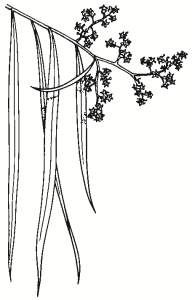Family:
Rutaceae
Geijera parviflora
Common Name
Other Names: Sheepbush, Dogwood, Willow.
First Nations Name(s):

Name Origin:
Geijera – After J.D. Geijer, early Swedish botanist.
parviflora — from Latin, meaning small-flowered.
Regional Subspecies:
Occurrence:
Regional:
Noted on sandy soil in The Rock-Henty-Milbrulong region. More common to the north-west of the SW Slopes.
Australia:
Qld, NSW, Vic, SA.
Habitat:
Mixed woodland communities on range of soils.
Habit:
Shapely spreading small tree or shrub to 10 m high. Often rounded, dense canopy of branches hanging to ground-level and narrow glossy dark-green leaves.
Site Preference:
Drought resistant and hardy.
Characteristics:
Deep-rooted. Leaves strongly aromatic when crushed. Palatable trees often grazed to uniform horizontal line above ground-level.
Flowering:
White, Jun-Nov. Small with strong odour. Strongly influenced by rainfall.
Seed Collection:
Easily collected when mature, as seeds abundantly. Can be gathered from ground beneath trees.
Propagation:
From fresh seed or cuttings, which are slow to root. Hard seed coat contains chemical inhibitors. Apply pressure to fracture and remove seed coat before sowing.
Regeneration:
From seed. Very few seedlings establish despite prolific seed production.
VALUES:
Shade & Shelter:
Excellent low-level cover in windbreaks due to low branching.
Wildlife:
Excellent habitat. Flowers are a nectar and pollen source used by native insects, including flies.
Timber:
Timber light-coloured, hard, close-grained with an agreeable fragrance. Tends to split in seasoning. Prone to gum veins.
Ornamental:
Excellent ornamental for wide streets, roadsides, parks, larger gardens, and shade. Requires adequate space to develop. Responds to pruning.
Other:
Useful emergency fodder in drought (although not all individual trees palatable).
